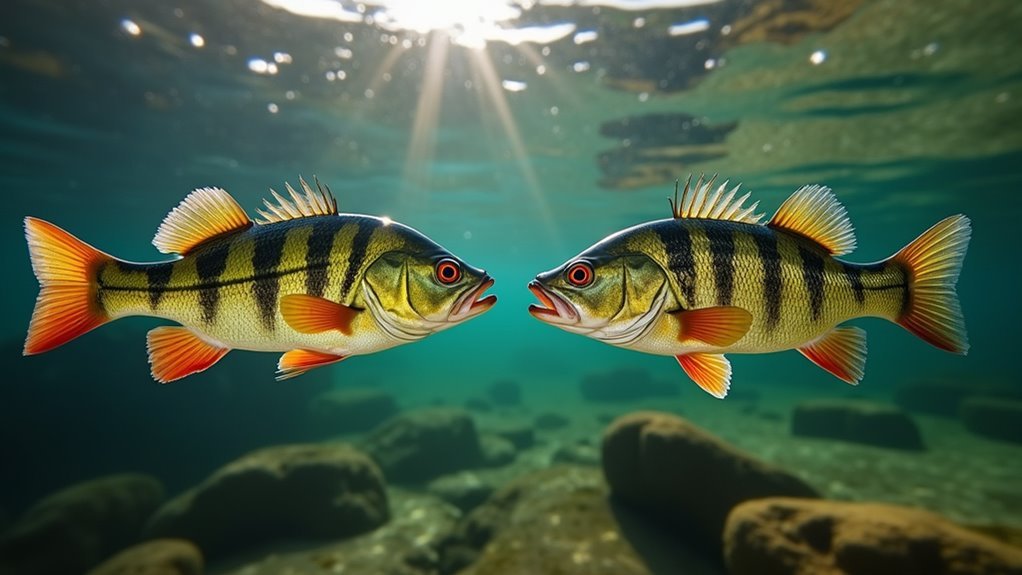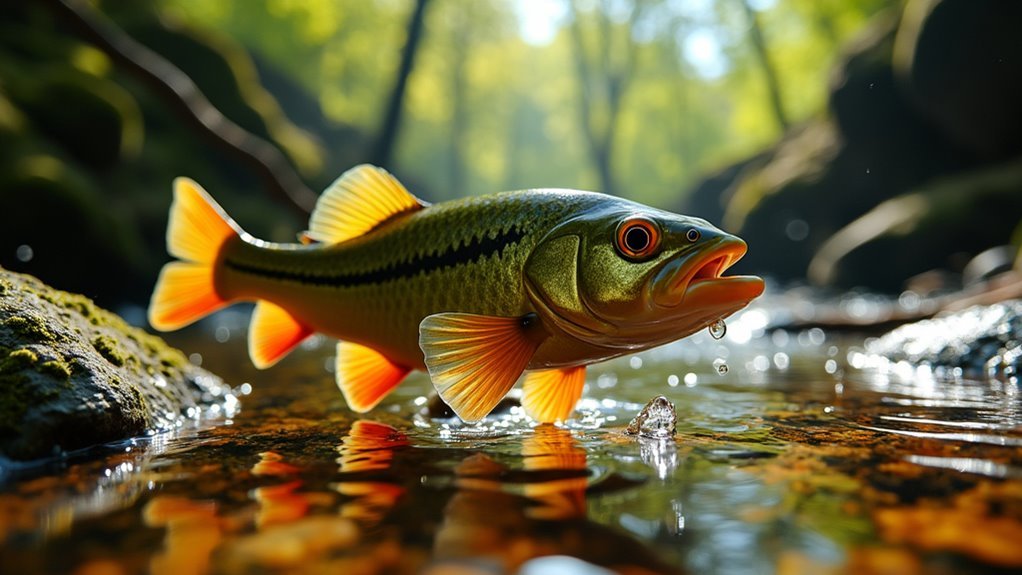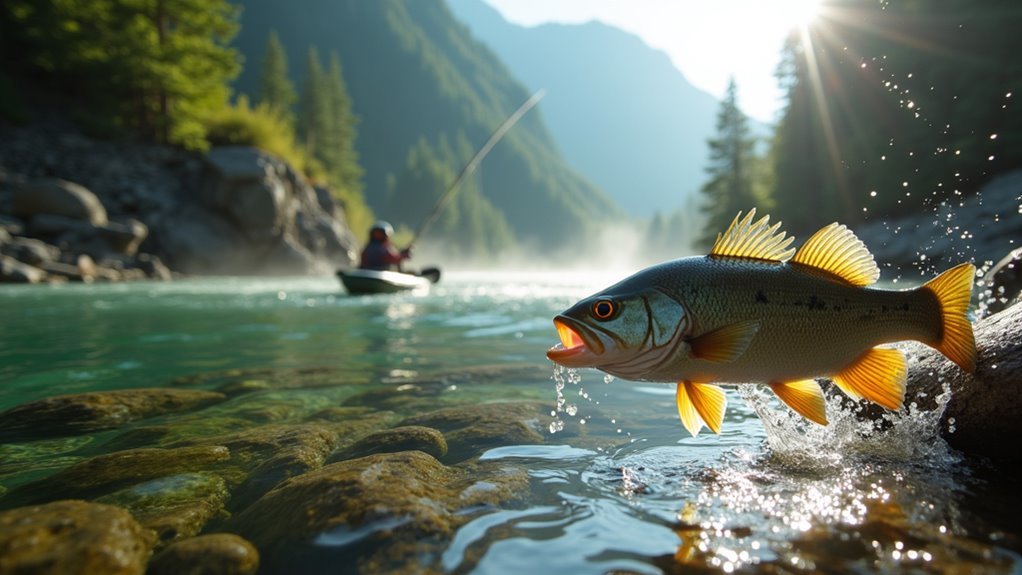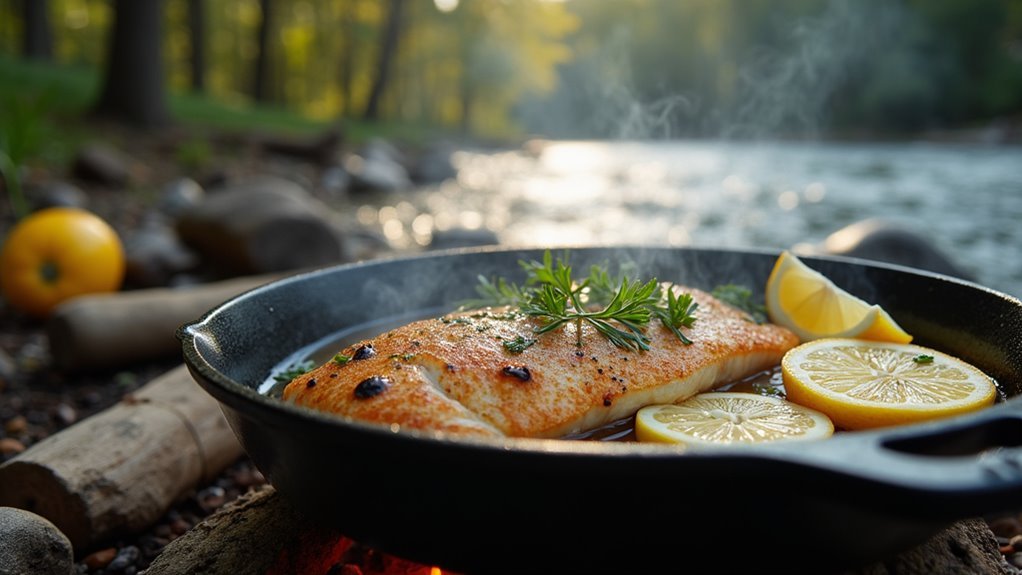Redeye bass are masters of disguise with their stunning crimson eyes and dark bronze bodies. We’ve tracked these elusive fighters primarily in Georgia and Alabama‘s clear mountain streams, where they hide under rocky overhangs and fallen trees. They’re actually split into four distinct species now, each with unique features. We’ve found approaching from downstream and using crayfish imitations works wonders during spring spawning when males show brilliant blue hues. The thrill of landing one is worth every careful cast.
The Distinctive Features of the Crimson-Eyed Predator

Masters of disguise among rocky creek beds, redeye bass reveal themselves with their unmistakable crimson eyes that seem to glow beneath the water’s surface. We’ve spotted these beauties countless times, their slender bodies showing off that dark bronze and olive green coloration that blends perfectly with creek bottoms.
Look for that distinctive dark spot on their gill cover—it’s a dead giveaway. Their orange-red tail with white-tipped edges is another telltale sign. We’ve found their pale bellies, which lighten to a brownish white, make them easier to spot when they turn sideways to strike a lure.
Taxonomy Debate: What Makes a True Redeye Bass?

While most anglers can easily spot a redeye bass in the water, the scientific community has been swimming in debate about what actually constitutes a true redeye.
Back in 2013, scientists split what we’d always called redeye bass (M. coosae) into four separate species. We’ve caught them all, and trust me, telling them apart isn’t easy without a microscope!
| Species | Key Feature | Native Range |
|---|---|---|
| M. cahabae | Tooth patches | Cahaba River |
| M. tallapoosae | Scale patterns | Tallapoosa Basin |
| M. warriorensis | Unique coloring | Warrior River |
| M. chattahoochae | Distinct fins | Chattahoochee River |
These differences matter to scientists, but for us weekend warriors, those crimson eyes still tell the story.
Finding the Elusive Redeye in Southeastern Waterways

Hunting for redeye bass requires more than just knowing their species classification—you’ve got to find them first! We’ve tracked these crimson-eyed beauties primarily through Georgia and Alabama’s Coosa River basin, with scattered populations in surrounding states.
Look for them in:
- Clear, cool mountain streams with rocky bottoms
- Shaded pools beneath overhanging trees
- Creek bends with underwater structure and debris
- Private land access points (network with locals!)
Remember when we fished Weiss Lake last spring? Those redeyes were hiding in plain sight! Access can be tricky, so befriend landowners or explore Georgia’s public waters.
Strategic Angling Techniques for Catching Redeye Bass

Three key techniques make all the difference when targeting redeye bass in their natural habitats. First, always approach from downstream—these wary fish spook easily. We’ve learned this lesson after many empty-handed trips!
Second, cast strategically, starting with the closest fish and working outward. This prevents alerting the whole pool to your presence.
Finally, match their natural diet with appropriate lures. Crayfish imitations and small baitfish patterns work wonders in the rocky streams they call home.
Remember to check consumption advisories before keeping your catch. We once filled a cooler from Lay Lake before learning about the PCB warnings!
From Stream to Table: The Culinary Value and Safety Considerations

Despite being one of the lesser-known game fish, redeye bass offer exceptional table fare that rivals their more famous cousins. We’ve found their meat to be deliciously flaky when properly prepared. However, we must be cautious about where we harvest them.
- Pollution advisories exist in several waters, particularly in Alabama
- Weiss Lake and Lay Lake have a one-fish-per-month limit due to PCB contamination
- Choccolocco Creek fish shouldn’t be consumed at all
- Proper filleting techniques greatly enhance meal quality
We always check local consumption advisories before keeping redeye bass for dinner. Trust us, when caught from clean waters, these crimson-eyed beauties make for a meal worth writing home about!
Spawning Patterns and Seasonal Behaviors
When spring arrives in the southeastern streams, redeye bass begin their annual spawning ritual with remarkable precision. Water temperatures between 63-68°F trigger their reproductive instincts, typically from April to June.
We’ve watched males transform before our eyes, taking on beautiful blue or green hues as they prepare their nests in hard-bottomed creek pools with gravel. They’re dedicated fathers, fiercely guarding both eggs and eventually fry while mama bass heads off to refuel.
Once, while fishing the Coosa, I spotted three males defending nests within yards of each other—nature’s rhythm in perfect harmony. It’s this predictable behavior that makes spring fishing so exciting.
Frequently Asked Questions
Can Redeye Bass Hybridize With Other Black Bass Species?
We don’t have specific information about redeye bass hybridization with other black bass species in our knowledge base. This would require additional research to confirm.
What Conservation Efforts Exist to Protect Native Redeye Populations?
We’re protecting redeye bass through habitat restoration, stricter fishing regulations, and monitoring programs. We’ve also established pure strain refuges and educational campaigns about the threat of hybridization to native populations.
How Do Redeye Bass React to Environmental Changes and Pollution?
PCB levels in Alabama’s Weiss Lake illustrate redeye bass’s vulnerability to pollution. We’ve noticed they’re highly sensitive to water quality changes, often withdrawing from polluted areas and showing reduced spawning success in compromised environments.
What’s the World Record for Redeye Bass Size?
We don’t have specific information about the world record for redeye bass size, though they’re particularly slow growers compared to shoal bass, which typically reach 1-1½ feet and 9 pounds.
Do Redeye Bass Migrate Seasonally Within River Systems?
You’d think these fish love to travel, but we’ve found little evidence redeye bass migrate seasonally. They typically stay within small home ranges, preferring stable habitats year-round in river systems.
Conclusion
We’ve uncovered the secrets of these crimson-eyed beauties throughout our journey together. Did you know that despite their modest size, redeye bass can live up to 12 years in their native streams? We’ve spent countless dawns watching them strike with lightning precision, and we’re certain you’ll feel the same thrill when you hook your first one. Remember, patience and light tackle are your best friends on these cool, rocky streams.